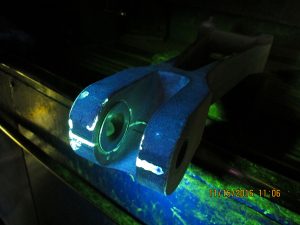Non-Destructive Testing
 Aircraft landing gears suffer many types of structural deterioration including corrosion, operation fatigue, and maintenance stress.
Aircraft landing gears suffer many types of structural deterioration including corrosion, operation fatigue, and maintenance stress.
It is critical to inspect surfaces for any damage that may exist in order to determine the extent of repair work needed, whether that occurs as the result of aircraft in service or during repair. ATI conducts all NDT testing on-site.
Magnetic Particle Inspection
Magnetic particle inspection is a method for detecting cracks, laps, seams, voids, pits, subsurface holes, and other surface, or slightly subsurface, discontinuities in ferromagnetic materials. MPI uses the tendency of magnetic lines of force, or flux, of an applied field to pass through the metal rather than through the air. A defect at or near the metal’s surface distorts the distribution of the magnetic flux, and some of the flux is forced to pass out through the surface.
| Specifications | |
|---|---|
| Magnetic Particle Inspection: |
|
Liquid Penetrant Inspection
Liquid Penetrant Inspection is a widely-applied method used to locate surface-breaking defects in non-porous material. This is achieved by treating an area with specially-formulated liquid to reveal flaws. LPI is used to detect surface defects such as hairline cracks, surface porosity, and fatigue cracks on components.
| Specifications | |
|---|---|
| Liquid Penetrant Inspection: |
|
Nital Etch
Nital Etch inspection is used widely to inspect aircraft parts before shot-peening or plating. Machining or grinding can introduce a tremendous amount of heat into a steel component. Nital Etch is used for checking machining damage or grinding burn of a hardened steel component.
| Specifications | |
|---|---|
| Nital Etch: |
|
For more information on our NDT capabilities please contact us.
